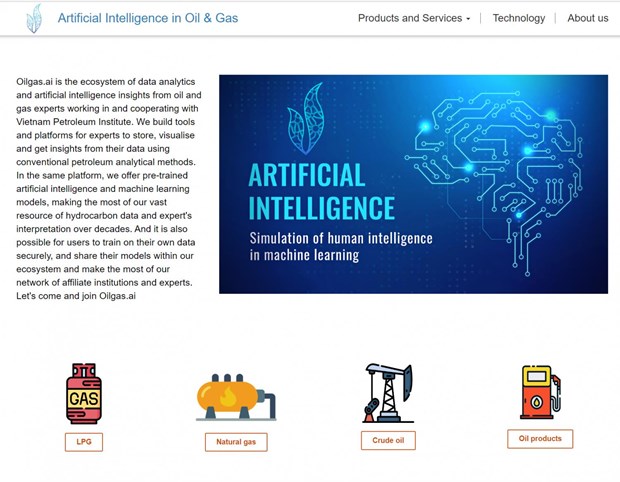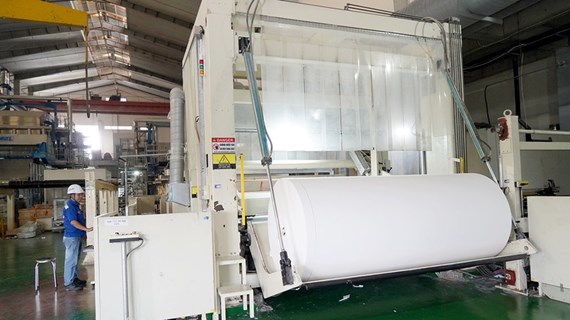VPI builds Oilgas AI ecosystem to maximise operations
 The Oilgas AI ecosystem applies artificial intelligence and machine learning. (Source: petrovietnam.petrotimes.vn)
The Oilgas AI ecosystem applies artificial intelligence and machine learning. (Source: petrovietnam.petrotimes.vn)Hanoi (VNA) – The Vietnam Petroleum Institute (VPI), a member of the
Vietnam Oil and Gas Group (PetroVietnam), has built an Oilgas AI ecosystem
using artificial intelligence and machine learning. The system is used to
collect and analyse in-depth data in the oil and gas sector, with products such
as crude oil, petroleum, liquefied petroleum gas and natural gas.
As a partner of Microsoft, VPI is taking measures to optimise the analysis, use
and management of data, thus helping firms improve work efficiency. The Oilgas
AI was built on the back of Microsoft’s Power Pages and incorporated with the
latest processing, analysis, connection and management tools such as Power Apps
(app development), Power Automate (task automation), Power BI (interactive data
visualisation) and Power Virtual Agents (smart virtual assistants).
For each product, Oilgas AI performs an analysis of market data, price
forecasting, supply and demand, infrastructure, and inventory. It also help users easily find, tap and interact with
vivid data through charts, reports, dashboards, and more. The data will be
constantly updated, making it easier for users to monitor real-time data.
In particular, petroleum suppliers, importers and sellers can monitor the retail
petrol price forecast through petroleum products at the Oilgas AI ecosystem.
Its petrol price forecast model uses machine learning algorithms to model input
data sources. It also continuously update new factors to provide the most
accurate prediction of provisions and expenditures using the Petroleum Price
Stabilisation Fund. It also inputs base prices of domestic and imported
petroleum products.
VPI Data Director Le Ngoc Anh said Oilgas AI targets becoming a network of
experts, scientists, organisations, businesses and consumers at home and abroad
on the back of using the latest technological advances like cloud computing, AI
and machine learning.
This ecosystem creates a
competitive advantage through the optimisation of analysis, mining and use of
data in a safe and convenient manner. It also employs the application and use
of models and algorithms that have been developed by VPI experts and other
leading specialists in the oil and gas sector who are cooperating with VPI.
Energy market products and services will provide solutions to help businesses
make faster and more effective decisions in daily production and business
activities, as well as devise long-term plans and strategies.
VPI has started providing a free data mining service for users to experience
the trial version of the Oilgas AI ecosystem at https://oilgasai.powerappsportals.com. Following the trial period, VPI will
provide optional service packages to meet the diverse needs of customers.
Previously, VPI also applied AI and machine learning to quickly identify the
presence of the fractured granite basement. The system has an accuracy rating
of over 80%, helping save exploration time and costs.
The discovery and successful exploitation of fractured granite basement
reservoirs at Bach Ho (White Tiger) and other oil fields in Vietnam have
changed the traditional oil and gas exploration viewpoint and contributed to
the formation of a new one in the region and the world.
However, the identification of fractured granite basement by using traditional
methods needs specialised equipment that may require suspension of oil well
drilling. This lengthens the rig rental duration (the current rental is about
65,000 - 68,000 USD per day), and raise expenses.
To optimise this process, the VPI has worked out a fracture prediction solution
that applies artificial intelligence and machine learning, helping to accurately
detect the presence of fracture systems basing on real-time data.
Relevant data will be used as inputs into machine learning algorithms, and then
models will be classified, ranked, and assessed to find out the best for
fracture prediction.
The VPI has tested the accuracy of this prediction model on drilling data of 12
wells in some fields with similar geological structures, showing a prediction
accuracy rate of a whopping 80%./.













